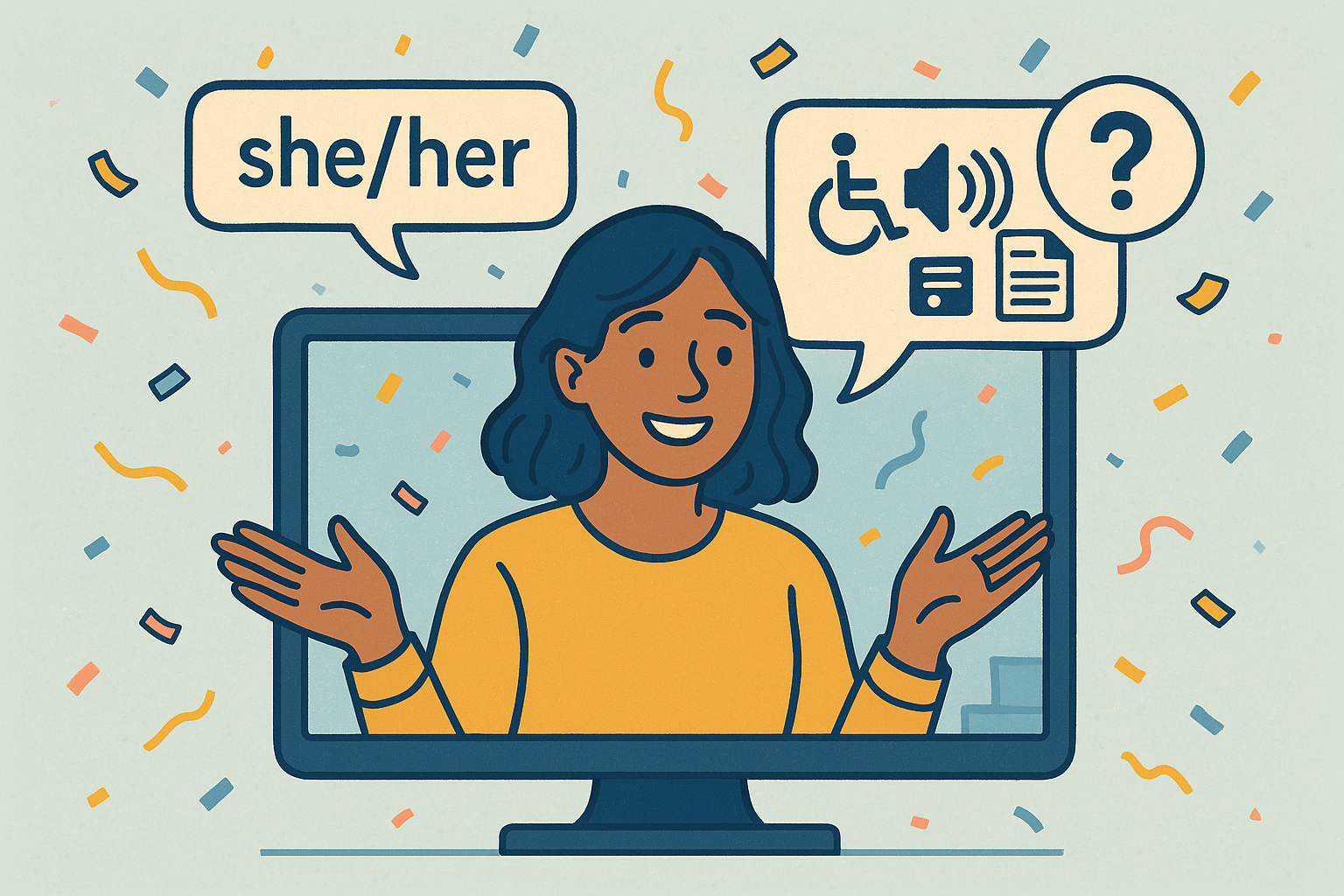Talk to Me First: How One Casual Question Changed Everything
A single, off‑hand question about accessibility turned my webinar from a nerve‑racking negotiation into proof that true inclusion feels effortless.

"Hi, I'm Eric, I use he/him pronouns, and I'm visually impaired."
In many circles, sharing pronouns has become as routine as shaking hands used to be (remember those days?). It's a simple act that speaks volumes about respect and inclusion. But when was the last time someone felt just as comfortable sharing their accessibility needs right off the bat?
I learned the power of this firsthand in 2020—the year we all became experts at virtual backgrounds and pretending our internet was "acting up" to dodge awkward meetings. Amidst the chaos of transitioning to remote everything, I was invited to speak at a month-long virtual conference for work. As someone who is visually impaired, virtual events often felt like navigating a maze with the lights off.
A week before my presentation, the conference organizers scheduled a dry run. We went through the usual motions: screen sharing, microphone checks, and making sure no one was stuck with a cat filter on their face (looking at you, Zoom mishaps). Just as we were about to wrap up, one of them casually asked, "By the way, would you like us to read the audience comments aloud during the live stream? Is there anything else we can do to make the experience better for you?"
I was stunned.
In that moment, a flood of emotions washed over me—relief, gratitude, even a touch of disbelief. Did they really just anticipate my needs without me having to muster the courage to bring it up? Usually, disclosing my visual impairment and requesting accommodations feels like tiptoeing through a minefield, worrying about being perceived as "difficult" or "needy." But here they were, treating my needs as a natural part of the process, no different from confirming the agenda or discussing the Q&A format.
My guard dropped. The knot in my stomach loosened. I didn't have to prepare a speech about why I needed certain accommodations or brace myself for possible pushback. Instead, I felt seen and valued. It was liberating.
On the day of the presentation, everything flowed seamlessly. The moderators read the comments aloud, allowing me to engage with the audience without missing a beat. Without the usual background stress, I was fully present, sharing my ideas and connecting with listeners. It was one of the most rewarding professional experiences I've ever had.
This got me thinking about how sharing pronouns has become second nature for many of us. What began as a conscious effort to respect individual identities has evolved into a standard courtesy. It's a simple practice that makes a significant difference in making people feel included from the start.
So why can't we do the same with accessibility?
Imagine starting meetings with something like, "Hi, I'm Jordan, I use she/her pronouns. Please let me know if there's anything I can do to make our collaboration better for you." By integrating both pronouns and an open invitation for accessibility needs into our introductions, we create a space where everyone feels comfortable sharing how they can best engage.
This practice isn't just beneficial for people with disabilities; it helps everyone. We all have unique ways we learn and communicate best. Some of us are visual learners, others prefer auditory information, and some thrive through hands-on experiences. By normalizing the sharing of our needs and preferences, we empower everyone to participate fully.
For those of us who often have to advocate for ourselves, this simple shift can be game-changing. It removes the emotional toll of deciding whether to disclose a disability or specific need, worrying about potential judgment or awkwardness. It turns the conversation from a hesitant request into a natural exchange.
Reflecting on my experience, I realized it wasn't just about that one presentation. It was about the broader implications of what true inclusion looks like. When people anticipate and acknowledge others' needs, it doesn't just make tasks easier—it makes people feel valued and respected.
So here's my challenge to you: The next time you're in a position to set the tone—whether it's a meeting, a class, or even a casual group activity—take that extra step. Include an open invitation for others to share their accessibility needs. You might say, "Feel free to let me know if there's anything that would help you engage more fully today."
And if you're comfortable, consider sharing your own preferences or needs. Not only does this normalize the practice, but it also encourages others to feel safe doing the same. You might be surprised at how this simple act can transform the dynamics of your interactions.
Let's take inspiration from the normalization of pronoun sharing and extend that same openness to accessibility. By doing so, we not only support those who might otherwise feel sidelined but also enrich our own experiences through everyone's full participation.
After all, life's too short—and Zoom meetings too long—to let unnecessary barriers prevent us from connecting with one another. When we proactively embrace accessibility, we build bridges instead of walls, fostering environments where everyone has the opportunity to thrive.
So, will you join me in making accessibility a natural part of our conversations? Share your experiences, successes, or even the challenges you've faced. Let's learn from each other and create a culture where inclusion isn't the exception—it's the norm.